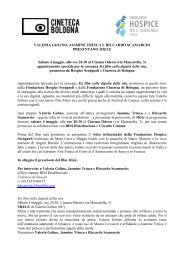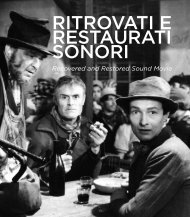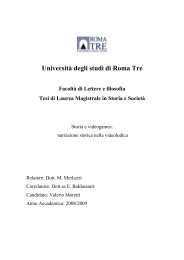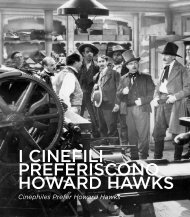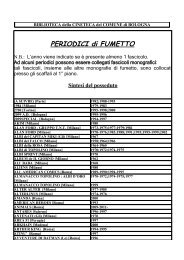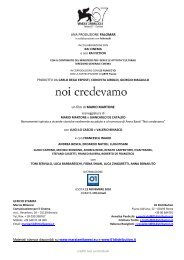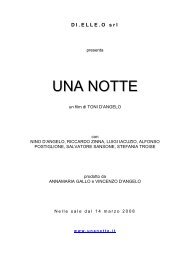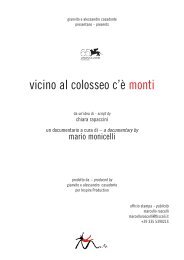Catalogo 1999 - Cineteca di Bologna
Catalogo 1999 - Cineteca di Bologna
Catalogo 1999 - Cineteca di Bologna
Create successful ePaper yourself
Turn your PDF publications into a flip-book with our unique Google optimized e-Paper software.
anche un film. Sempre con Reinhardt, la Carmi apparve in Eine venezianische Nacht (1912), “sapido impasto <strong>di</strong> burla, <strong>di</strong> sogno<br />
e <strong>di</strong> comme<strong>di</strong>a dell’arte mista a romanticismo nor<strong>di</strong>co” (Savio).<br />
Ritornata in patria, la Cines ne fece la protagonista <strong>di</strong> Retaggio d’o<strong>di</strong>o (1914), audace tentativo <strong>di</strong> film<br />
psicologico, regia <strong>di</strong> Nino Oxilia. Dopo altri due film, tra cui La mia vita per la tua (1914), soggetto <strong>di</strong><br />
Matilde Serao, l’attrice <strong>di</strong>vise con Giovanni Grasso e la Balestrieri il vedettariato del mitico Sperduti<br />
nel buio e fu poi accanto alla grande tragica Giacinta Pezzana in Teresa Raquin. Allo scoppio della<br />
guerra, seguì il marito in Germania ove rimase fino al termine delle ostilità; nel cinema tedesco <strong>di</strong>venne<br />
popolarissima attraverso una ventina <strong>di</strong> film oggi tutti andati perduti, salvo Rächende Liebe (La<br />
vendetta dell’amore, 1917), fortunamente ritrovato nei fon<strong>di</strong> della cineteca <strong>di</strong> Mosca.<br />
Atteggiamento altero, tratti signorili, una maschera severa ma dalle sfumature dolci, Maria Carmi fu<br />
ideale interprete <strong>di</strong> quei melò destinati al pubblico alto e me<strong>di</strong>o-borghese, continuando sullo schermo<br />
una tra<strong>di</strong>zione <strong>di</strong> prima donna <strong>di</strong> stile ottocentesco, alla quale veniva richiesto assieme alle doti<br />
professionali una avvenenza ed un fascino <strong>di</strong> qualità essenzialmente amorosa.<br />
Nel 1920 la Carmi <strong>di</strong>vorzia da Vollmöller e torna in Italia, dove i suoi film tedeschi, dopo una accurata<br />
degermanizzazione, vengono presentati come film italiani per eludere il boicottaggio ancora in atto<br />
verso i prodotti tedeschi. Anche se vecchi <strong>di</strong> cinque o sei anni, hanno un esito <strong>di</strong>screto, mentre critiche<br />
feroci e sonori <strong>di</strong>ssensi incontra Forse che sì, forse che no (1922), dal romanzo <strong>di</strong> D’Annunzio, regia<br />
del francese Gaston Ravel. Delusa e amareggiata, la Carmi chiude con il cinema e torna alle scene: al<br />
Teatro degli In<strong>di</strong>pendenti <strong>di</strong> Bragaglia interpreta Marinetti, Pirandello ed altri. Chiamata in America da<br />
Reinhardt per una ripresa de Il miracolo, che poi non ebbe luogo, l’attrice sposa a New York il principe<br />
georgiano Matchabelli, apre una scuola <strong>di</strong> recitazione, poi si darà agli stu<strong>di</strong> esoterici. (Vittorio<br />
Martinelli)<br />
Maria Carmi (Norina Gilli 1880-1957). Married to German playwright Karl Vollmöller, Maria Carmi<br />
decided to become an actress on Max Reinhardt’s advice and attended his acting school. Reinhardt<br />
offered her an exceptional debut with Das Mirakel (1911), a stage pantomime which had had its<br />
première in London the previous year and was adapted for the screen in 1912. Again with Reinhardt,<br />
Carmi appeared in Eine venezianische Nacht (1912) “a tasty mix of farce, fantasy and comme<strong>di</strong>a<br />
dell’arte held together by northern romanticism” (Savio).<br />
After returning to Italy, Cines signed her up for Retaggio d’o<strong>di</strong>o (1914), a bold attempt to make a<br />
psychological film, <strong>di</strong>rected by Nino Oxilia. After two features, inclu<strong>di</strong>ng La mia vita per la tua (1914),<br />
written by Matilde Serao, the actress appeared with Giovanni Grasso and Balestrieri in the legendary<br />
Sperduti nel buio and then in Teresa Raquin with great tragic actress Giacinta Pezzana. At the onset of<br />
the war she followed her husband in Germany where she stayed till the end of the conflict; she became<br />
extremely popular in German cinema thanks to around twenty films which have all been lost, except for<br />
Rächende Liebe (1917), fortunately re<strong>di</strong>scovered in the Moscow film archive.<br />
Haughty, with classic features, a severe expression sweetened by soft hues, Maria Carmi was the ideal<br />
actress for melodramas tailored to the taste of high and middle-class au<strong>di</strong>ences, continuing on the<br />
screen the tra<strong>di</strong>tion of the nineteenth-century prima donna, who was appreciated not only for her<br />
acting but also for her essentially erotic beauty and charm.<br />
In 1920 Carmi <strong>di</strong>vorced Vollmöller and came back to Italy, where her German films, after being<br />
thoroughly de-Germanized, were <strong>di</strong>stributed as Italian features in order to bypass the boycott against<br />
German products. Already five or six years old, they were quite successful, while ferocious criticism<br />
and high-voiced <strong>di</strong>ssension were meted out for Forse che sì, forse che no (1922), based on<br />
D’Annunzio’s novel, and <strong>di</strong>rected by French Gaston Ravel.



